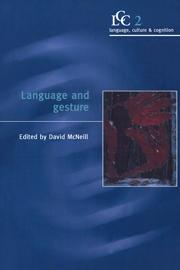Book contents
- Frontmatter
- Contents
- Acknowledgments
- Introduction
- Part 1 Gesture in action
- Part 2 Gesture in thought
- Part 3 Modeling gesture performance
- 13 Lexical gestures and lexical access: a process model
- 14 The production of gesture and speech
- 15 Catchments and contexts: non-modular factors in speech and gesture production
- Part 4 From gesture to sign
- Index
15 - Catchments and contexts: non-modular factors in speech and gesture production
Published online by Cambridge University Press: 07 January 2010
- Frontmatter
- Contents
- Acknowledgments
- Introduction
- Part 1 Gesture in action
- Part 2 Gesture in thought
- Part 3 Modeling gesture performance
- 13 Lexical gestures and lexical access: a process model
- 14 The production of gesture and speech
- 15 Catchments and contexts: non-modular factors in speech and gesture production
- Part 4 From gesture to sign
- Index
Summary
Introduction
The present chapter joins that by McNeill & Duncan in this volume to present the concept of a growth point. The aim of the chapter is to articulate some of the implications of this concept for models of speaking. When concrete utterances are examined for their growth-point sources, they are found to include information and groupings of information that are inconsistent with modularity-based information-processing models. What growth points can model naturally, information-processing models are systematically prevented from modeling – the contextualization of speech, gesture, and the thinking-for-speaking which they embody. Thus, I present the current chapter as a challenge to modular information-processing-type explanations of speech–gesture productions. Incorporating context conflicts with the encapsulation axiom shared by modular models. This axiom can be stated in something like the following terms: a complex mental process is modeled by breaking it down into a series of less complex processes (modules) each of which is encapsulated in the sense that it reacts only to specific inputs and has no information about or influence upon the internal operations of the other modules. Incorporating context conflicts with encapsulation because it means allowing the internal structure of a module to be altered by the context of speaking. The problem can't be solved by programming context into the module, because modularity requires the recurrence of internal steps (cf. Gigerenzer & Goldstein 1996), while context is precisely that which is unpredictable and non-recurrent. In contrast, growth points incorporate context at a foundational level; they are undefined without it.
- Type
- Chapter
- Information
- Language and Gesture , pp. 312 - 328Publisher: Cambridge University PressPrint publication year: 2000
- 36
- Cited by

